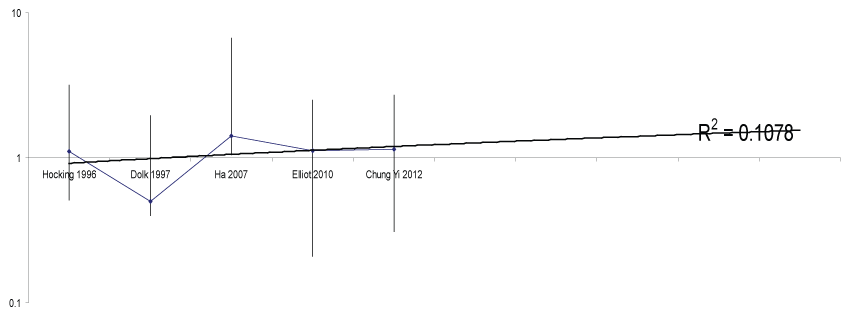International Journal of Cancer and Clinical Research
Microwave/Radiofrequency (MW/RF) Radiation Exposure and Cancer Risk: A Meta-analysis of Time-related Trends in the Accumulated Empirical Evidence
Iris Atzmon1*, Boris Portnov2, Shai Linn1,3 and Elihu D Richter4
1School of Public Health, University of Haifa, Israel
2Department of Natural Resources & Environmental Management, Faculty of Management, University of Haifa, Israel
3Unit of Clinical Epidemiology, Rambam Medical Center, Haifa, Israel
4Unit of Occupational and Environmental Medicine, Hebrew University of Jerusalem, Hadassah Medical Center, Israel
*Corresponding author:
Iris Atzmon, School of Public Health, University of Haifa, Israel, P.O box 6536 Haifa, E-mail: atzmonh@bezeqint.net
Int J Cancer Clin Res, IJCCR-3-039, (Volume 3, Issue 1), Research Article; ISSN: 2378-3419
Received: October 21, 2015 | Accepted: January 25, 2016 | Published: January 27, 2016
Citation: Atzmon I, Portnov B, Linn S, Richter ED (2016) Microwave/Radiofrequency (MW/RF) Radiation Exposure and Cancer Risk: A Meta-analysis of Time-related Trends in the Accumulated Empirical Evidence. Int J Cancer Clin Res 3:039. 10.23937/2378-3419/3/1/1039
Copyright: © 2016 Atzmon I, et al. This is an open-access article distributed under the terms of the Creative Commons Attribution License, which permits unrestricted use, distribution, and reproduction in any medium, provided the original author and source are credited.
Abstract
Background: Scientific debate regarding health effects from MW/RF radiation has increased considerably in recent years. In the early 1980's much of the evidence concerning the health effects of MW/RF radiation came from occupational studies, however, in the 1990's and the 2000's, environmental studies became more dominant. This resulted from an increase in public awareness about exposure to MW/RF radiation. It remains unclear, however, whether scientific evidence gathered so far supports a general expectation that estimated cancer risks attributed to MW/RF radiation, will increase over time in conjunction with rapid proliferation of MW/RF technology. This study attempts to answer this question.
Study goal: The study follows time-related changes in the body of scientific evidence associating cancer risk with MW/RF radiation.
Methods: 57 studies, published over 30 years (between 1982 and 2012), and addressing the association between exposure to MW/RF radiation and cancer risk, were analyzed using time-trend analysis tools.
Results: No significant 'upward' trend was uncovered in the association between MW/RF radiation and cancer, during comparison of earlier and more recent studies.
Conclusions: Early occupational studies found higher associations of risk, compared to later environmental studies which detected relatively lower risks, possibly due to lower and less homogeneous exposure settings in the latter group. It is difficult to draw conclusions whether this fact alone led the lack of 'upward' time-related trends, in the degree of a link between MW/RF radiation and cancer, and further studies are needed.
Keywords
Time trends, Occupational and environmental studies, MW/RF radiation, Strength of association, Latency period
Introduction
Public exposure to microwave/radiofrequency (MW/RF) radiation has been increasing rapidly since the development and proliferation of wireless technologies [1-6], resulting in widespread health concerns [7-13]. According to International Telecommunication Union's estimates (Figure 1), in 2001 there were 962 million cellular phone users across the globe, in 2010 5,290 million and in 2015 7,085 million. In addition to environmental exposure, occupational exposure to MW/RF radiation has also increased, due to a widespread use of wireless technology in hospitals, clinics, medical laboratories and implanted medical devices [14].
The proliferation of MW/RF radiation has been a health concern for years [7-13]. Thus, in an early study by Milham [15], television and radio repairmen had an increased risk of leukemia mortality. This was also revealed by Pearce [16] in TV and radio repairmen. Increased risk of leukemia morbidity was likewise detected in an early study by Coleman [17], who investigated radio and telegraph operators, and by Calle [18] and Mcdowall [19], who studied leukemia mortality in radio and telegraph operators. Milham [20,21], who investigated several occupational groups exposed to electromagnetic fields, also found increased risk for acute leukemia mortality, mortality from myeloid leukemia and all leukemia in male members of the American Radio Relay League, residing in Washington and California. In two early studies, Milham [22,23] revealed significant increased mortality from lymphatic cancers, including multiple myeloma and non-Hodgkin's lymphoma among amateur radio operators and lymphatic and hematopoietic cancers among the technician class of amateur radio operators.
In more recent studies, MW/RF radiation-cancer links were investigated, inter alia, by Maskarinec [24], Hocking [25], Dolk [26,27] McKenzie [28], Cooper [29], Michelozzi [30], Ha [31], Hocking [7], Park [8], Eger [9], Wolf [10], Ha [11], Merzenich [32], Elliot [33] and Chung Yi [13]. Thus, Hocking [7] found a statistically significant association between residential proximity to television towers and a decrease in survival rates among children with leukemia in North Sydney, Australia. In 2004, two further studies found increased cancer risk among neighborhoods located close to cellular towers [9,10]. In yet another study published in 2004, Park [8] found higher rates of leukemia mortality among young adults aged less than 30 years residing in urban areas surrounded by AM radio broadcasting towers.
In a study published three years later, Ha [11] found an increased risk of lymphocytic leukemia among children residing in areas surrounded by AM radio transmitters whilst in Belo Horizonte, Brazil, Dode [12] found higher mortality among residents whose homes were located within a radius of 500 meters from base stations, when compared with the average mortality rate of the city as a whole.
Despite the emerging body of scientific evidence regarding a MW/RF-cancer association, to the best of our knowledge, there have been no attempts to analyze time-related trends of the strength of MW/RF-cancer risk association between earlier and more recent studies. To the best of our knowledge, the present study is the first one that attempts to look into the time related changes in the detected strength of the relationship between MW/RF radiation and cancer in both occupational and environmental settings.
Study Methods
Data sources
We analyzed peer-reviewed papers published between 1982 and 2012 dealing with MW/RF radiation associated with cancer. A total of 57 papers, retrieved using the Google Scholar search engine were reviewed. Out of the 57 studies collected, 4 studies were excluded because they did not contain epidemiologic analysis [34,35] reported a very high result that masked other studies' results on the graph (there was one underlying cause of death due to leukemia compared with 0.2 expected (standard mortality ratio [SMR] = 437, 95% confidence interval [CI] = 11-2433), and two multiple listed causes of death due to leukemia compared with 0.3 expected (SMR = 775, 95% CI = 94-2801)] [36] or used a case series method with no epidemiological ratios and/or probability values [37].
Association indices
We considered all types of association ratios. The most common measures of risks in studies were OR, RR followed by SMR. Odds Ratio (OR) represents the odds of a disease in the exposed vs. the odds in the non-exposed. Odds ratio is most commonly used in case control studies. PMR gives results similar to SMR (personal communication with Dr. Sam Milham, Decoufle [38]), while for a rare disease like cancer, RR is approximately equal to the OR [39].
SIR (Standardized Incidence Ratio) is the relationship between the rate of specific disease in the chosen population, and the rate of the same disease in the general population, standardized for age, gender and other relevant parameters or, when death is the outcome, SMR (standardized mortality ratio) [40,41].
Proportional Incidence Ratio (PIR), Proportional Registration Ratio (PRR), Direct Standardized Mortality Rate (MRR) and crude death rate per 1000.
Analytical methods
The analysis was performed in several steps. First we ordered all studies collected by the year of publication, and examined changes in the strength of association over time between exposure to MW/RF radiation and cancer. We performed the analysis by graphing time-related trends of association separately for several types of malignancies. We entered data of associations found in the studies into Excel program files. Studies were ordered on X axis, independent variable, by year of publication. The dependent variable, Y axis, represents the strength of association. Logarithmic transformations were used in order to increase the resolution over the different associations, and to identify the line of 1 to make the level of association visually clear. Studies were ordered by years in order to take into consideration the possibility of trends in years. In order to not lose data, we included several results of the same study, in these cases the name of the author appears more than once on the same graph.
In order to determine whether the results were statistically significant, time trend-analysis was performed, using WinPepi software (WinPepi© J.H Abramson version 11.47) [42], to examine the relationship between date and the reported strength of association related to radiation exposure. The WinPepi© computers programs for epidemiologists were designed as learning or teaching aids for use in practice and research in the health field. WinPepi© is the Windows version of the DOS-based PEPI (an acronym for Programs for EPI demiologists) package, which grew from a set of programs for programmable pocket calculations published in 1983 [42].
Results
The results of the analysis are shown in table 1 and figures 2, figure 3, figure 4, figure 5, figure 6 and figure 7. The results are presented according to the measure Kendall's tau. Kendall's tau is a non-parametric measure of correlation between two ranked variables. It is the difference between the probability that the observed data are in the same order versus the probability that the observed data are not in the same order.
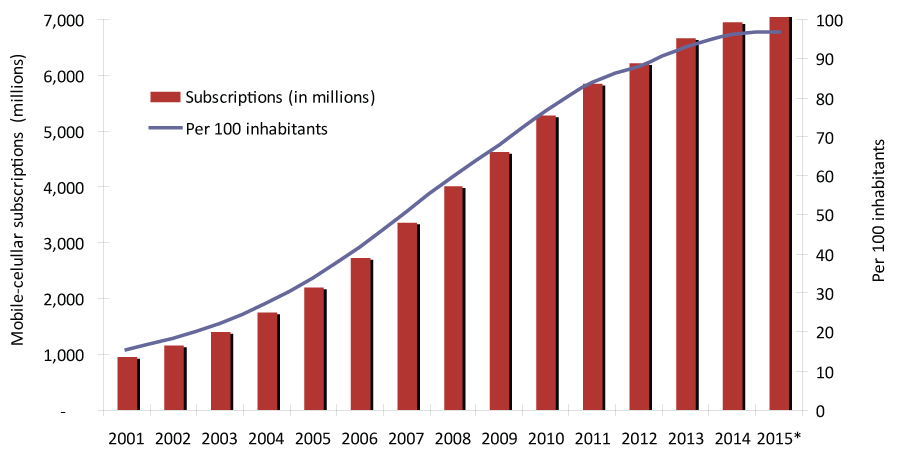
.
Figure 1: Global mobile-cellular subscriptions, total and per 100 inhabitants, 2001-2015.
View Figure 1
![]()
Table 1: Overall associations between RF exposure and different types of cancer.
View Table 1
There was a suggestion of some upward trends, but not at levels of significance for melanoma morbidity (Figure 5) [R2 = 0.2511; Kendall's tau b = 0.355 (95% CI -0.496-0.858; p > 0.05]; all cancer sites morbidity [R2 = 0.0821; Kendall's tau b = 0.053 (95% CI -0.576-0.642 p > 0.05], brain cancer mortality, morbidity in adults and morbidity in children (Figure 2, Figure 3 and Figures 4) [R2 = 0.926; Kendall's tau b = 0.386 95% CI (-0.412-0.849) p > 0.05]; [R2 = 0.0822; Kendall's tau b = 0.216 95% CI (-0.505-0.760) p > 0.05]; [R2 = 0.1078; Kendall's tau b = 0.400 95% CI (-0.596-0.911) p > 0.05], respectively.
For leukemia morbidity in adults (Figure 6), morbidity in children and mortality in adults, stable trends were detected.
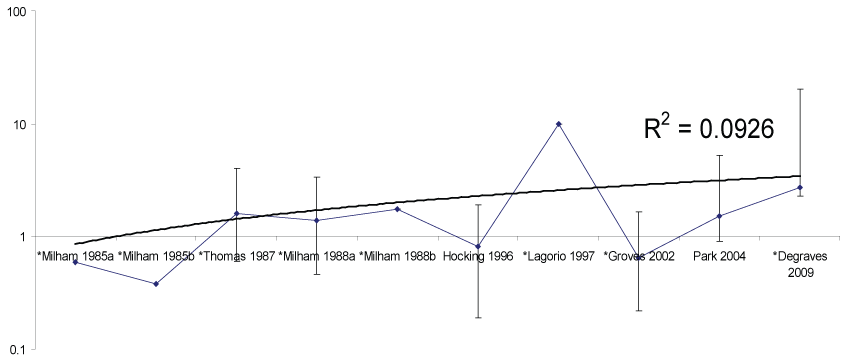
.
Figure 2: Association between exposure to MW/RF and mortality from brain cancer.
*Occupational studies
View Figure 2
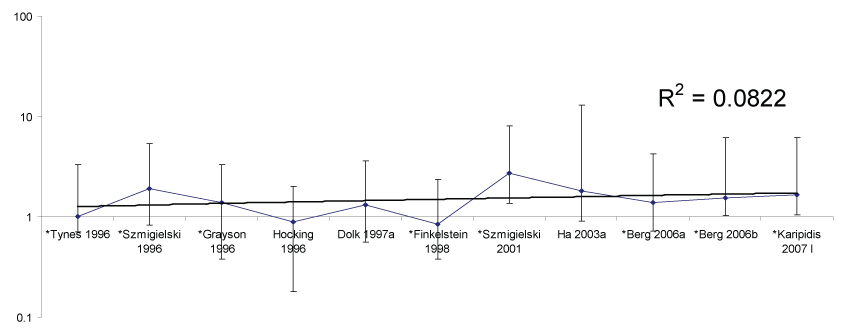
.
Figure 3: Association between exposure to MW/RF and brain cancer morbidity.
*Occupational studies
View Figure 3
For several cancer types, early occupational studies had higher measures of association vs. later environmental studies. For example, on the graph of lymphoma morbidity (Figure 7), an early occupational study [43] found for non-hodgkin's lymphoma observed/expected ratios (OER) = 5.82 (95% CI 2.11, 9.74) The OER were calculated using the non-exposed group as reference. Thus corresponding to the odds ratio. For breast cancer morbidity, an early occupational study [44], found an elevated measure of association for communication and broadcasting men workers OR = 2.9 OR represents the odds of a disease in the exposed vs. the odds in the non-exposed. On the graph of testicular cancer (morbidity), two early occupational studies [45,46] found highly significant associations. On the graph of all cancer sites mortality, one early occupational study [47] found especially high correlation (crude death rate per 1000 = 7.23, 95% CI 1.2788, 40.8775; CI calculated by WinPepi© program) for one category of exposure. In this study on 40,000 of the US Naval personnel, the authors concluded that no adverse effects were detected that could be attributed to potential microwave radiation exposures. However, the study was re-analyzed by Goldsmith [47], who found that death rates for the group with the highest exposure, aviation electronics technicians (AT), were significantly higher than those for the remaining men for all deaths, disease-related death, deaths from malignancy and death from malignancy of the lymphatic and hematopoietic systems. Although this group had a higher mean age at the beginning of the study (23.4) than the average of the whole group (21.3), this mean age was younger than the average for aviation electrician's mates AE (24.7), a category that showed no increase in deaths from any malignancy or from other diseases. According to Goldsmith [47], when the authors adjusted for age, they combined the AT group with the fire control technicians (FT) group, which had a low malignancy rate. These two groups were about the same size and had 10 and 1 cases of lymphatic or hematological malignancies, respectively [47]. When earlier occupational studies with higher correlations were removed to test if the trend was influenced by the type of studies (occupational vs. environmental), they were found to have had visual influence (the trend became upwards when removed) but not statistically significant, therefore no conclusions can be drawn. Complete separation between environmental and occupational studies in analysis did not change the results.
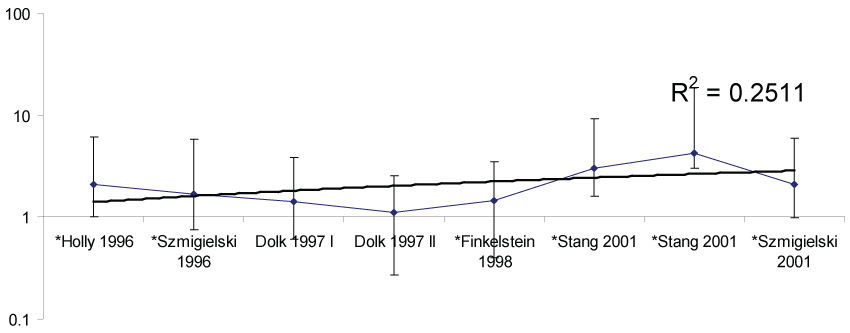
.
Figure 5: Association between exposure to MW/RF and melanoma morbidity.
*Occupational studies
View Figure 5

.
Figure 6: Association between exposure to MW/RF and adult leukemia morbidity.
Generally a stable trend is seen over the years
View Figure 6
Discussion
We could not detect any significant upward time-related trend in the strength of association between RF/MW radiation and cancer. Higher strength of association found in occupational studies vs. lower strength of association found in later published environmental studies, influenced visual trends of the graphs.
The differences between the strengths of associations in occupational vs. environmental studies may be related to the difference in exposure conditions in occupational vs. environmental studies. Occupational settings tend to have higher exposures and closer to the source of radiation vs. environmental settings with lower ambient exposures, greater distances from the source of exposure, taking into account that the intensity is falling quickly with increasing distance. However, many biological effects are reported at the low levels from environmental exposures [3,48].
Both environmental and occupational studies have limitations, due to confounders and exposure assessment deficits, misclassification of exposure or effect measured and the healthy worker effect bias that is specific to occupational studies. The healthy worker effect bias signifies the healthier health status of people who are able to work. In occupational studies, the mortality and morbidity rates within the workplace are lower than in the general population [49]. These factors may lead to an underestimation of risk. In environmental studies it is especially difficult to detect and control confounders or changes in exposure time. Misclassification of exposure is a recognized potential source of underestimation of risk and would provide an explanation for the negative findings. Also, latency of the effect might obscure associations. However, since both the decreasing and increasing trends were not statistically significant it is difficult to draw conclusions, and further studies may provide more answers.
Study Limitations
Our study has inherent limitations based on the limitation of individual studies, especially the limited information on exposure assessment and the lack of confounders on the individual level. Another limitation may be a short latency period and recent exposure to the wireless technologies.
Conclusion
Early occupational studies found higher associations of risk compared to later environmental studies which detected relatively lower risks, possibly due to lower and less homogeneous exposure settings in the latter group. It is difficult to draw conclusions whether this fact alone led the lack of 'upward' time-related trends, in the degree of a link between MW/RF radiation and cancer, and further studies are needed.
Acknowledgement
We would like to thank Dr. Joe Abramson for reviewing the methodology with regard to WinPepi.
References
-
Hutter HP, Moshammer H, Wallner P, Kundi M (2004) Public perception of risk concerning celltowers and mobile phones. Soz Praventivmed 49: 62-66.
-
Kundi M, Hutter HP (2009) Mobile phone base stations-Effects on wellbeing and health. Pathophysiology 16: 123-135.
-
Levitt BB, Lai H (2010) Biological effects from exposure to electromagnetic radiation emitted by cell tower base stations and other antenna arrays. Environ Rev 18: 369-395.
-
Bolte JF, Eikelboom T (2012) Personal radiofrequency electromagnetic field measurements in The Netherlands: exposure level and variability for everyday activities, times of day and types of area. Environ Int 48: 133-142.
-
Günter Vermeeren, Ioannis Markakis, Francis Goeminne, Theodoros Samaras, Luc Maretns, et al. (2013) Spatial and temporal RF electromagnetic field exposure of children and adults in indoor micro environments in Belgium and Greece. Progress in Biophysics and Molecular Biology 113: 254-263.
-
Estenberg, J, Augustsso T (2013) Extensive frequency selective measurements of radiofrequency fields in outdoor environments performed with a novel mobile monitoring system. Bioelectromagnetics 35: 227-230.
-
Hocking B, Gordon I (2003) Decreased survival for childhood leukemia in proximity to television towers. Arch Environ Health 58: 560-564.
-
Park KS, Ha M, Im Hyung-Jun (2004) Ecological study on residences in the vicinity of AM radio broadcasting towers and cancer death: preliminary observations in Korea. Int Arch Occup Environ Health 77: 387-394.
-
Eger H, Hagen KU, Lucas B, Vogel P, Voit H (2004) Einfluss der räumlichen Nähe von Mobilfunksendeanlagen auf die Krebsinzidenz. Umwelt-Medizin-Gesellschaft 17: 273-356.
-
Wolf D, Wolf R (2004) Increased incidence of cancer near a cellular phone transmitter International Journal of Cancer Prevention 1(2).
-
Ha M, Im H, Lee M, Kim HJ, Kim BC, et al. (2007) Radio-frequency radiation exposure from AM radio transmitters and childhood leukemia and brain cancer. Am J Epidemiol 166: 270-279.
-
Dode AC, Leão MM, Tejo Fde A, Gomes AC, Dode DC, et al. (2011) Mortality by neoplasia and cellular telephone base stations in Belo Horizonte municipality, Minas Gerais state, Brazil. Science of the Total Environment 409: 3649-3665.
-
Li CY, Liu CC, Chang YH, Chou LP, Ko MC (2012) A population-based case-control study of radiofrequency exposure in relation to childhood neoplasm. Sci Total Environ 435-436: 472-8.
-
FDA (2013) Guidance Radio Frequency Wireless Technology in Medical Devices.
-
Milham S Jr (1982) Mortality from leukemia in workers exposed to electrical and magnetic fields. N Engl J Med 307: 249.
-
Pearce NE (1988) Leukaemia in electrical workers in New Zealand: a correction. Lancet 2: 48.
-
Coleman M, Bell J, Skeet R (1983) Leukaemia incidence in electrical workers. Lancet 1: 982-983.
-
Calle EE, Savitz DA (1985) Leukemia in occupational groups with presumed exposure to electrical and magnetic fields. N Engl J Med 313: 1476-1477.
-
McDowall ME (1983) Leukemia mortality in electrical workers in England and Wales. Lancet 1: 246.
-
Milham S Jr (1985) Mortality in workers exposed to electromagnetic fields. Environ Health Perspect 62: 297-300.
-
Milham S Jr (1985) Silent keys: leukaemia mortality in amateur radio operators. Lancet 1: 812.
-
Milham S Jr (1988) Increased mortality in amateur radio operators due to lymphatic and hematopoietic malignancies. Am J Epidemiol 127: 50-54.
-
Milham S Jr (1988) Mortality by license class in amateur radio operators. Am J Epidemiol 128: 1175-1176.
-
Maskarinec G, Cooper J, Swygert L (1994) Investigation of increased incidence in childhood leukemia near radio towers in Hawaii: preliminary observations. J Environ Pathol Toxicol Oncol 13: 33-37.
-
Hocking B, Gordon IR, Grain HL, Hatfield GE (1996) Cancer incidence and mortality and proximity to TV towers. Med J Aust 165: 601-605.
-
Dolk H, Shaddick G, Walls P, Grundy C, Thakrar B, et al. (1997) Cancer incidence near radio and television transmitters in Great Britain. I: Sutton Coldfield transmitter. Am J Epidemiol 145: 1-9.
-
Dolk H, Elliott P, Shaddick G, Walls P, Thakrar B (1997) Cancer incidence near radio and television transmitters in Great Britain. II. All high power transmitters. Am J Epidemiol 145: 10-17.
-
McKenzie DR, Yin Y, Morrell S (1998) Childhood incidence of acute lymphoblastic leukaemia and exposure to broadcast radiation in Sydney--a second look. Aust N Z J Public Health 22: 360-367.
-
Cooper D, Hemmings K, Saunders P (2001) Re: "Cancer incidence near radio and television transmitters in Great Britain. I. Sutton Coldfield transmitter; II. All high power transmitters" [Letter]. Am J Epidemiol 153: 202-204.
-
Michelozzi P, Capon A, Kirchmayer U, Forastiere F, Biggeri A, et al. (2002) Adult and childhood leukemia near a high-power radio station in Rome, Italy. Am J Epidemiol 155: 1096-1103.
-
Ha M, Lim HJ, Cho SH, Choi HD, Cho KY (2003) Incidence of cancer in the vicinity of Korean AM radio transmitters. Arch Environ Health 58: 756-762.
-
Merzenich H, Schmiedel S, Bennack S, Brüggemeyer H, Philipp J, et al. (2008) Childhood leukemia in relation to radio frequency electromagnetic fields in the vicinity of TV and radio broadcasting transmitters. American Journal of Epidemiology 168: 1169-1178.
-
Elliott P, Toledano MB, Bennett J, Beale L, de Hoogh K, et al. (2010) Mobile phone base stations and early childhood cancers: case-control study. BMJ 340: c3077.
-
Selvin S, Schulman J, Merrill DW (1992) Distance and risk measures for the analysis of spatial data: a study of childhood cancers. Soc Sci Med 34: 769-777.
-
Hallberg Ö, Johansson O (2002) Melanoma incidence and frequency modulation (FM) broadcasting. Arch Environ Health 57: 32-40.
-
Muhm JM (1992) Mortality investigation of workers in an electromagnetic pulse test program. J Occup Med 34: 287-292.
-
Stein Y, Levy-Nativ O, Richter ED (2011) A sentinel case series of cancer patients with occupational exposures to electromagnetic non-ionizing radiation and other agents Eur. J. Oncol 16: 1-34.
-
Decouflé P, Thomas TL, Pickle LW (1980) Comparison of the proportionate mortality ratio and standardized mortality ratio risk measures. Am J Epidemiol 111: 263-269.
-
Kleinbaum DG, Kupper LL, Morgenstern H (1982) Epidemiologic Research Principles and Quantitative Methods. Canada: John Wiley & Sons.
-
Rothman, KJ, Greenland S and Lash TL (2008) Modern Epidemiology. USA: Lippincott Williams & Wilkins.
-
Modan B (1998) Epidemiology. Israel: Papyrus Tel Aviv University.
-
Abramson JH (2011) WINPEPI updated: computer programs for epidemiologists, and their teaching potential. Epidemiol Perspect Innov 8: 1.
-
Szmigielski S (1996) Cancer morbidity in subjects occupationally exposed to high frequency (radiofrequency and microwave) electromagnetic radiation. The Science of the Total Environment 180: 9-17.
-
Demers PA, Thomas DB, Rosenblatt KA, Jimenez LM, McTiernan A, et al. (1991) Occupational exposure to electromagnetic fields and breast cancer in men. Am J Epidemiol 134: 340-347.
-
Hayes RB, Brown LM, Pottern LM, Gomez M, Kardaun JW, et al. (1990) Occupation and risk for testicular cancer: a case-control study. Int J Epidemiol 19: 825-831.
-
Davis RL, Mostofi FK (1993) Cluster of testicular cancer in police officers exposed to hand-held radar. Am J Ind Med 24: 231-233.
-
Goldsmith JR (1997) Epidemiologic evidence relevant to radar (microwave) effects. Environ Health Perspect 105 Suppl 6: 1579-1587.
-
Bioinitiative Report (2012) RF Color Charts.
-
Li CY, Sung FC (1999) A review of the healthy worker effect in occupational epidemiology. Occup Med (Lond) 49: 225-229.





